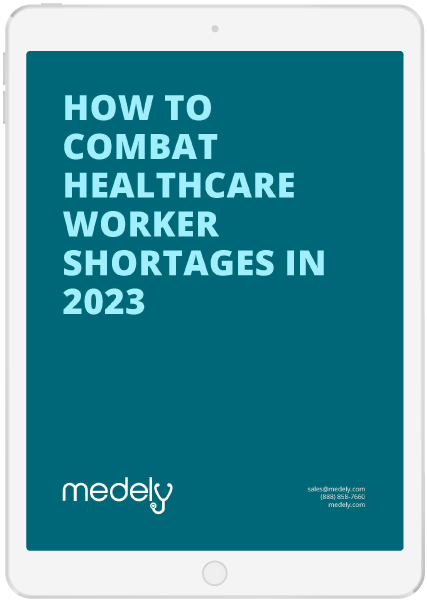The demand for post-acute care facilities is rapidly growing as a large population, particularly Baby Boomers and Gen X, start to progress into their older years. And, this demand for care is increasing faster than the supply of registered nurses available to help provide their much-needed care. To maintain high-quality care for the growing volume of patients, these facilities need to overcome the effects of a long-term shortage of nurses and work on building a creative, innovative staffing model for assisted living facilities and other post-acute care facilities.
For post-acute care facilities, staffing methods that have worked for years may no longer be effective. Agencies are expensive and slow, and many facility managers and administrators are feeling burnt out by the amount of scheduling they are responsible for to keep their facilities fully-staffed.. Today, a staffing solution for a post-acute care facility is a flexible solution that balances each patient’s medical and safety needs, the well-being and satisfaction of the nursing staff, and the facility’s bottom line.
This updated staffing model for assisted living effectively manages workloads, employee churn, burnout avoidance, and satisfaction for nurses and the patients who rely on them for the best possible care.
Learn more about Medely’s staffing solution and how we help post-acute care facilities here.
The impact of the nursing shortage on post-acute care facilities
In a survey conducted by the American Association of Critical-Care Nurses, 76% of participants reported inadequate staffing in their facilities. The shortage has hit post-acute care facilities especially hard, making it difficult at times for hospitals to transfer patients. Some patients may be sent to facilities further away from home and family. Meanwhile, post-acute care facilities often must raise the ratios of patients to staff, jeopardizing the quality of care and contributing to burnout among nurses.
In addition to its effect on patient care, the shortage is a major influence on post-acute care facilities’ bottom lines. One study conducted in 2022, for example, estimated that the nursing shortage could cause these facilities to forego, collectively, $19.5 billion in revenue.

Building an effective staffing model for assisted living facilities
So, how do you maintain an efficient staffing model despite this critical shortage? You create a new staffing model for assisted living by exploring new ideas. Adopt innovations that help you balance the needs of your patients and those of your staff. There are several options to discuss with your team.

Make full use of HPPD data
The Centers for Medicare & Medicaid Services (CMS) has assigned great importance to employee churn. Their audits focus on four measures: total weekend nurse staffing hours per patient per day (HPPD) plus, within one year, the total turnover for all nurses, registered nurses, and administrators.
In addition to fulfilling CMS requirements, your HPPD data is an effective tool to streamline services, reduce expenses, and increase productivity. It identifies areas where staff is not optimized for the best patient care, which allows you to make adjustments that reduce and increase revenue. Most importantly, HPPD helps ensure that you always have the staff needed to keep patients safe and well cared for.
Provide competitive compensation
How competitive are your total compensation and perks? Of course, the more you can offer, the happier your staff will be. But you don’t have to break your budget to create an attractive, much-appreciated package. Consider the following, for example:- Base salary
- Benefits
- Bonuses
- Pay differentials (for working second shifts versus weekends)
- Flexible work hours (supporting work-life balance)
- Paying for staff development and education
- Recognition programs
Adopt supportive technology
Frequently, new software and platforms emerge to help streamline your staffing efforts, including:- EMR. A New England Journal of Medicine survey identified communication and collaboration for post-acute care as a critical issue for post-acute care facilities. Updating electronic medical records so that your patient records are available in multiple locations can support communication and collaboration, reduce confusion, and ease patient transfers between facilities.
- Scheduling. Forecasting scheduling needs is made easier with scheduling software. Beyond creating a timetable, this software can increase productivity by predicting workloads, analyzing real-time data, and placing staff in areas with the greatest needs. Work can be distributed evenly among staff, avoiding expensive overtime and burnout and enhancing employee satisfaction.
Luckily, Medely empowers healthcare facilities to optimize their workforce, taking back control from costly staffing agencies. Our innovative technology is configured specifically to your needs and uses data-driven decision making to help facilities seamlessly connect with verified nurses and healthcare professionals, cut agency and overtime costs, reduce churn, and secure full coverage.
Create staffing flexibility
Your staffing levels need to rise and fall with the needs and ratios of your patients. How can you ensure you are fully staffed without exhausting and burning out your staff?- Offer flexible shifts. Have you considered breaking away from the typical eight or 12-hour shift? Adjusting those hours gives you greater flexibility when covering needs for days, nights, weekends, and weekdays. And if you seek nurses’ input in the process, their job satisfaction will increase.
- Keep registered nurses focused on their most essential duties. Throughout the workday, there are routine tasks that don’t require a registered nurse’s expertise, such as documentation completion. You can often assign these tasks to Licensed Practical Nurses or unlicensed assistive personnel. That way, the RNs at your facility can remain focused on more advanced patient care.
- Create staffing pools. Float pools schedule nurses to work among multiple units. This ensures adequate coverage where and when it’s needed, and nurses gain cross-training opportunities. In one hospital system, for example, nurses working in a staffing pool for 26 weeks were assigned to various hospitals. This resulted in more consistent staffing and increased pay for the nurses.
- Try team-based care. Nurses are grouped into a team that shares the care for a specific group of patients. Team members support one another, easing the pressure to provide the highest quality care.
Hire contingent staff as needed
Another means of creating staffing flexibility and building an effective staffing model for assisted living facilities is contingent staffing. Bringing in contingent nurses on a part-time, on-demand basis helps ensure that you always have the coverage you need without overloading your full-time staff.
A contingent worker can actually cost less compared to full-time staff. According to one study, full-time staff cost between 1.9 and 2.2 times the hourly wage and 33% more than contingent staff. When the workload has temporarily eased, full-time staff generates high overhead costs, which lowers profit margins.
This contingent staffing option provides a cost-effective supplement to full-time staff when you need additional people on board.
Medely: Technology and flexibility supporting your staffing model
Post-acute care facilities are pressured to address patient demand without overworking their full-time staff. A powerful solution often comes from a source of supplemental, as-needed staffing. Medely’s platform offers an on-demand extension to your workforce – book registered nurses, certified nursing assistants, and licensed vocational and practical nurses at the click of a button. Plus, Medely will handle the credentialing. You can use our dashboard to review nurses’ credentials, handle billing and scheduling, and track shifts and timesheets all in one place.Why Medely for post-acute care facilities
Assisted living facilities, hospice facilities, long-term acute care hospitals, and skilled nursing facilities use Medely’s platform to gain access to hundreds of thousands of experienced and credentialed independent professionals, including RNs, certified nursing assistants (CNAs), licensed vocational (practical) nurses (LVNs), long-term care RNs, and more.Easily find experienced independent healthcare professionals on-demand
Fill shifts at your post-acute care facility with Medely. Our platform gives you access to thousands of credentialed and experienced independent healthcare professionals. Post your request, and we’ll notify you once it’s booked. Review credentials and track shift statuses from a single dashboard.Simplified credentialing
Our team works closely with independent healthcare professionals to manage their credentials. The Medely platform even sends reminders and alerts for renewals.Gain direct access to healthcare professionals
Medely’s post-acute staffing platform provides access to independent healthcare professionals ready to fill shifts and provide exceptional patient care.One place for tracking and timesheets
You can easily track the status of shift and assignment requests, manage timesheets, and pay invoices, all from one user-friendly system.Conclusion
The recruitment process can be challenging. Embracing a creative, innovative staffing model for assisted living is a powerful means to overcome the obstacles generated by the shortage of nurses and provide the highest-quality care for patients in need.

How to effectively combat healthcare labor shortages in 2024
Learn how to effectively combat healthcare labor shortages with an extended workforce to maintain continuity of care and gain access to tools you can use to manage your extended workforce more effectively and efficiently. In this eBook, you’ll learn:
- ■ Why nurses are leaving full-time jobs behind.
- ■ The factors impacting healthcare professional employment.
- ■ How you can use an extended workforce to meet demand.
- ■ How you can use data-led staffing planning to manage costs.



